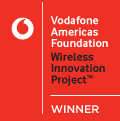Mobicom 2009 Paper
A paper on the networking aspects of EnHANTs, titled “Challenge: Ultra-Low-Power Energy-Harvesting Active Networked Tags (EnHANTs)”, will appear in the 2009 ACM MOBICOM conference (acceptance ratio ~10%).
First Prize in the Vodafone Americas Foundation Wireless Innovation Projects competition
The EnHANTs team wins the first prize in the Vodafone Americas Foundation Wireless Innovation Projects competition.
Professors Gil Zussman, Peter Kinget, John Kymissis, Dan Rubenstein, and Xiaodong Wang, won the first prize in the Vodafone America Foundation's "Wireless Innovation Project" competition, which had nearly 100 university and non-profit applicants. The competition identifies and funds unique innovations using wireless related technology offering the best potential to address critical social issues around the world. The Columbia team will use the associated funding to support their project, "Active Networked Tags for Disaster Recovery Applications". The project focuses on developing a system that uses wireless devices to track and locate survivors trapped by fires and structural collapse. The system is based on energy harvesting tags using ultra low power communications. The project draws upon the team's diverse research expertise in energy harvesting materials and devices, ultra low power electronics, wireless communications, and networking.
For additional details, please see the Wireless Innovation Project’s website and the press release.
Google Research Award
Professors John Kymissis, Peter Kinget, Dan Rubenstein, and Gil Zussman received a Google Research award for their project "Self-Powered, Networked Tags for Active Tracking of Physical Objects". The objective of the project is to design hardware, algorithms, and software to enable active tracking of physical objects using small self-powered, networked tags. This interdisciplinary project will build on the team's expertise in energy-harvesting devices and techniques, ultra-low power integrated circuits, and energy efficient networking protocols to develop a solution that takes advantage of cross-layer design optimizations. The integrated solution will enable a variety of tracking and monitoring applications beyond what RFID and other localization and identification technologies permit.

